 |
 |
 |
| |
SVR Tied to Lower Progression, Mortality in HIV/HCV+ With Moderate Fibrosis - the importance of treating coinfected patients
|
| |
| |
53rd ICAAC, September 10-13, 2013, Denver
from Jules: SVR reduced risk for AIDS progression and serious liver-related events in non-advanced as well as in patients with advanced HCV disease, thus as the authors say all HIV+ patients should be treated for HCV quick without undue delay, delaying therapy risks progression of HIV & HCV, even for patients with non-advanced disease but of course mores for patients with advanced disease. With the expected availability of new HCV therapies later this year but with peg interferon, and in 2014 IFN-free regimens with 95-100% SVR rates in phase 2 are expected to become available, coinfected patients should be treated without undue delay. If you view the slides below on "Rates of Events" you will see progression to AIDS, liver decompensation, HCC, overall mortality & liver-related mortality is reduced by as much as 10-fold.
Mark Mascolini
Sustained virologic response (SVR) to interferon plus ribavirin (IFN/RBV) with nonadvanced or moderate fibrosis lowered the risk of mortality and liver-related progression in a large Spanish cohort of people with HIV/HCV coinfection [1]. The benefit was most pronounced in people with moderate (METAVIR F2) liver fibrosis.
Previous work established the benefits of eradicating HCV in people with advanced fibrosis or cirrhosis. But researchers working with the GESIDA 3606 Study Cohort observed that the clinical benefits of attaining SVR have not been established in people with less advanced fibrosis. They argued that this question is especially relevant for HIV/HCV-coinfected people. The GESIDA team conducted this retrospective analysis to assess the impact of IFN/RBV-induced SVR on mortality, liver-related events, and HIV progression in HIV/HCV-coinfected people with biopsy-proved nonadvanced liver fibrosis.
The study group consists of people with HIV and HCV who began IFN/RBV between January 2000 and January 2008 at 19 clinical centers across Spain. Baseline liver biopsies in all participants had a METAVIR score of F0, F1, or F2. Follow-up continued from the time IFN/RBV stopped until the last study visit, a second course of IFN/RBV, or death.
Among 695 people who met those criteria, 77 (11%) had a METAVIR score of F0, 290 (42%) had F1 fibrosis, 328 (47%) had F2 fibrosis, and 274 (39%) achieved SVR. Most people in the SVR and no-SVR groups (69% and 75%) were men, while CD4 counts averaged 562 and 536. The groups were similar in median age (39.8) and weight (68 kg), proportion with low educational level (62%), proportion of prior injection drug users (83%), and proportion with an undetectable HIV load (66%). The proportion of people with CDC category C disease was lower in the SVR group than in the no-SVR group (16% versus 22%, P < 0.05).
People who attained SVR included a lower proportion with HCV genotype 1 or 4 (44% versus 76%, P < 0.05) and thus a higher proportion with genotype 2 or 3 (56% versus 24%). The SVR group also included a lower proportion with a pretreatment HCV load at or above 500,000 IU/mL (62% versus 76%, P < 0.05) and a lower proportion who drank more than 50 g of alcohol daily (2% versus 6%, P < 0.05). METAVIR fibrosis scores did not differ significantly between people who attained SVR and those who did not.
Three variables predicted SVR: HCV genotype 2 or 3 (odds ratio [OR] 4.24, 95% confidence interval [CI] 2.91 to 6.19), pretreatment HCV load below 500,000 IU/mL (OR 1.88, 95% CI 1.27 to 2.78), and drinking less than 50 g of alcohol daily (OR 4.04, 95% CI 1.11 to 14.8).
Through 96 months of follow-up, cohort members who attained SVR had significantly lower Kaplan-Meier-estimated overall mortality (P = 0.010), liver-related mortality (P = 0.024), liver decompensation (P = 0.010), and liver-related events (which included liver-related death, liver decompensation, hepatocellular carcinoma, and liver transplantation) (P < 0.001).
Among people with an F2 METAVIR score, people who achieved SVR had significantly lower mortality (0.29 versus 1.07 per 100 person-year [py]), liver-related mortality (0.07 versus 0.53 per 100 py), AIDS incidence (0.14 versus 0.69 per 100 py), and liver decompensation rate (0.22 versus 1.31 per 100 py) (P < 0.05 for all differences) than people who did not attain SVR. An analysis focused on people with F2 fibrosis found that those attaining SVR had significantly lower mortality (0.16 versus 1.57 per 100 py), liver-related mortality (0.16 versus 1.05 per 100 py), and liver decompensation rate (0.16 versus 1.85 per 100 py) (P < 0.05 for all differences) than people who did not attain SVR. Among people with a METAVIR score of F0 or F1, these progression rates did not differ significantly between those who attained SVR and those who did not.
Cox regression analysis to determine risk of liver-related events according to METAVIR fibrosis stage adjusted for age, gender, history of injection drug use, CDC clinical category, CD4 count, HCV genotype, and HCV load. In this analysis people who attained SVR with F0 to F2 fibrosis or with F2 fibrosis had almost a 90% lower risk of progression, as indicated in the following list. The group with F0 or F1 fibrosis had about an 80% lower risk of progression, but this difference stopped short of statistical significance:
Progression risk with SVR versus no SVR:
METAVIR F0-F2: adjusted hazard ratio (aHR) 0.13, 95% CI 0.03 to 0.59, P = 0.008
METAVIR F2: aHR 0.11, 95% CI 0.01 to 0.86, P = 0.035
METAVIR F0-F1: aHR 0.21, 95% CI 0.02 to 1.94, P = 0.169
The GESIDA team concluded that "eradication of HCV in HIV/HCV-coinfected patients with nonadvanced liver fibrosis (F0 to F2), and, more specifically, with moderate stages of liver fibrosis (F2), is associated with a reduction in the risk of mortality and liver-related events." They argued that these findings "constitute a strong rationale for considering anti-HCV treatment in this population group, particularly treatment based on the newer and more effective direct antiviral agents."
ReferenceL
1. Berenguer J, Zamora FX, Díez C, et al. Hepatitis C eradication reduces liver decompensation, HIV progression, and death in HIV/HCV-coinfected patients with non-advanced liver fibrosis. 53rd ICAAC. September 10-13, 2013. Denver. Abstract H-1527.
-----------------------------------------
Hepatitis C Eradication Reduces Liver
Decompensation, HIV progression, and
Death in HIV/HCV-coinfected Patients
with non-Advanced Liver Fibrosis
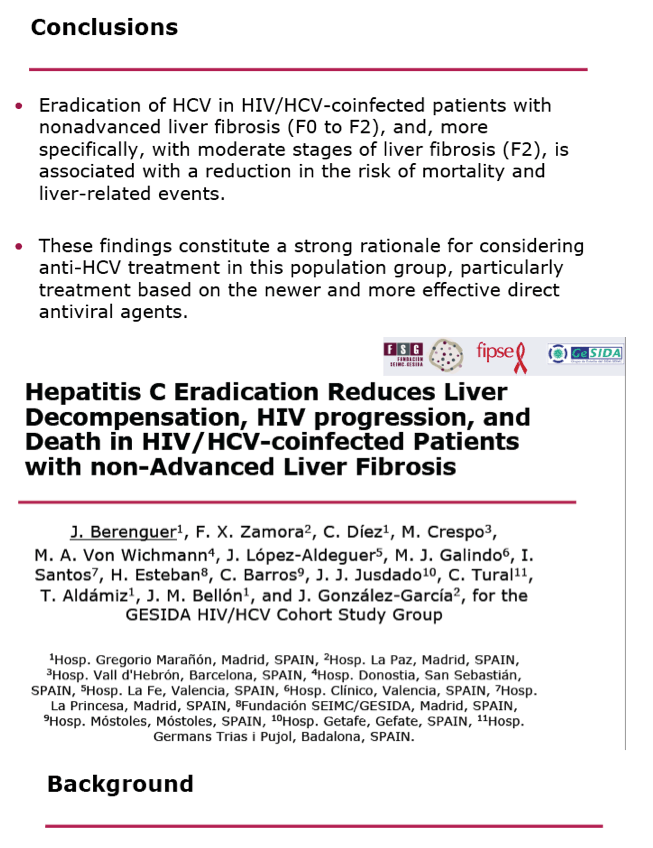


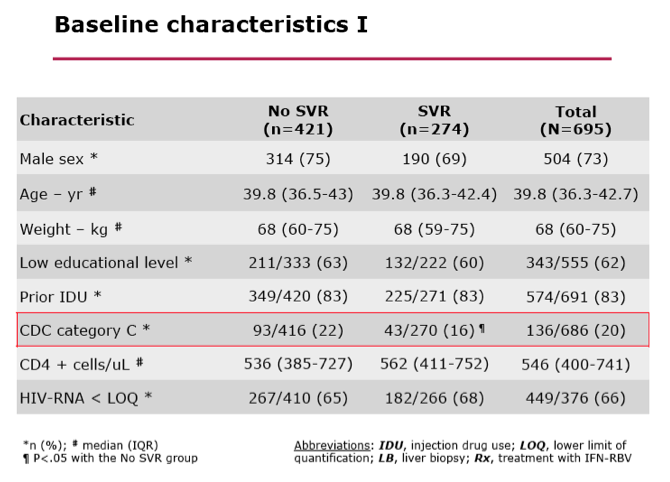
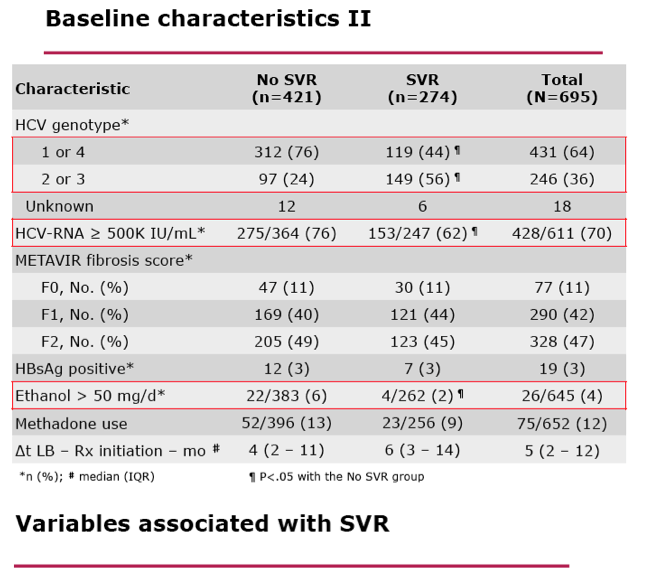
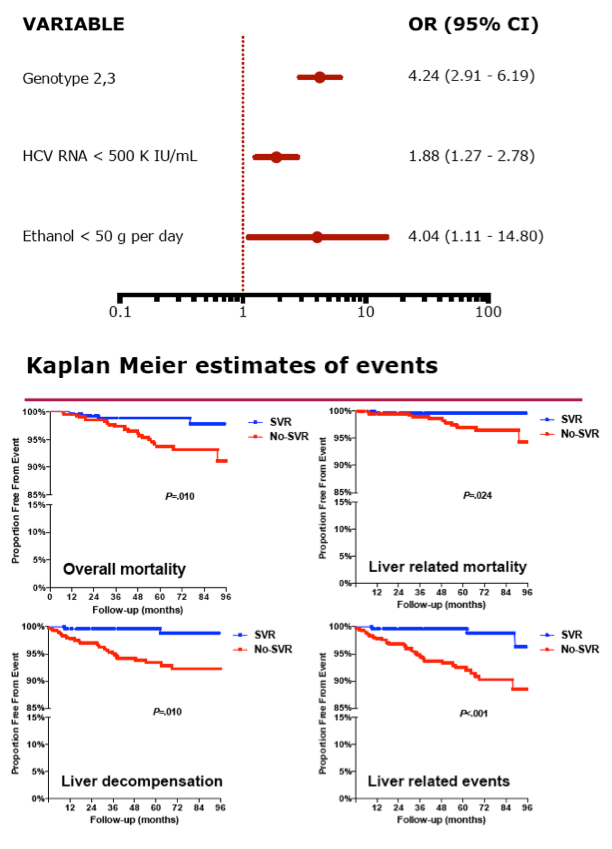
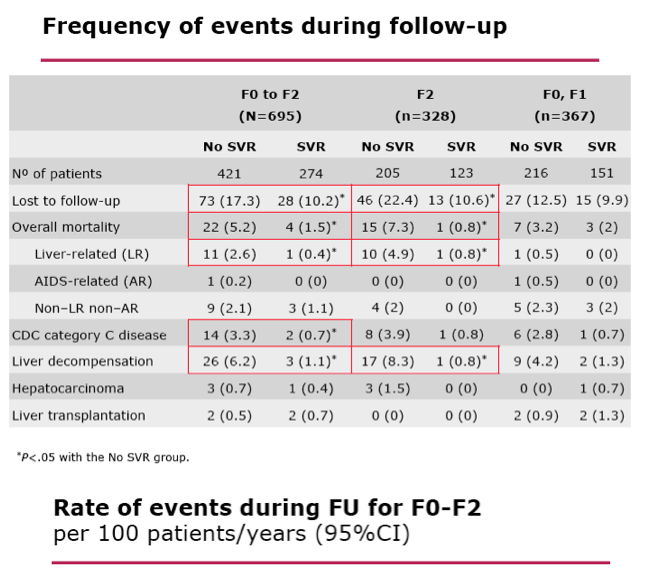

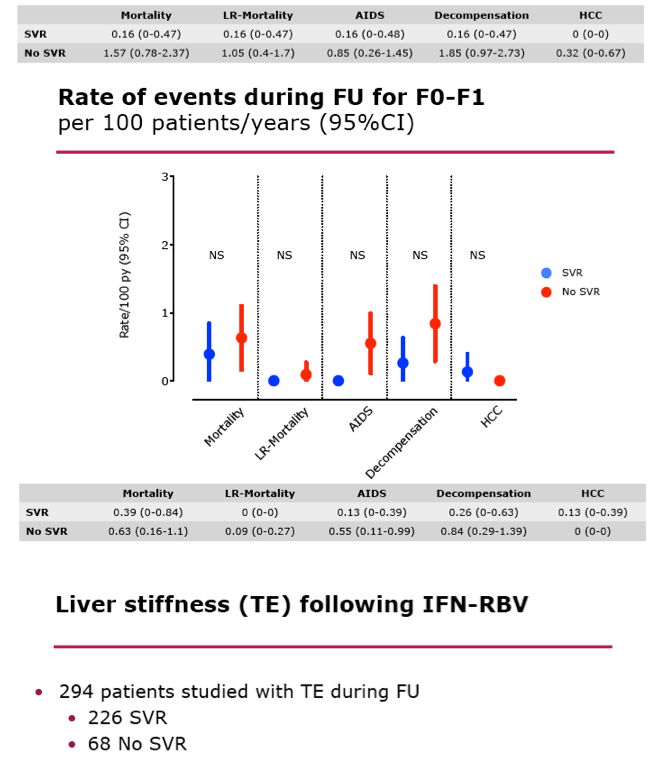
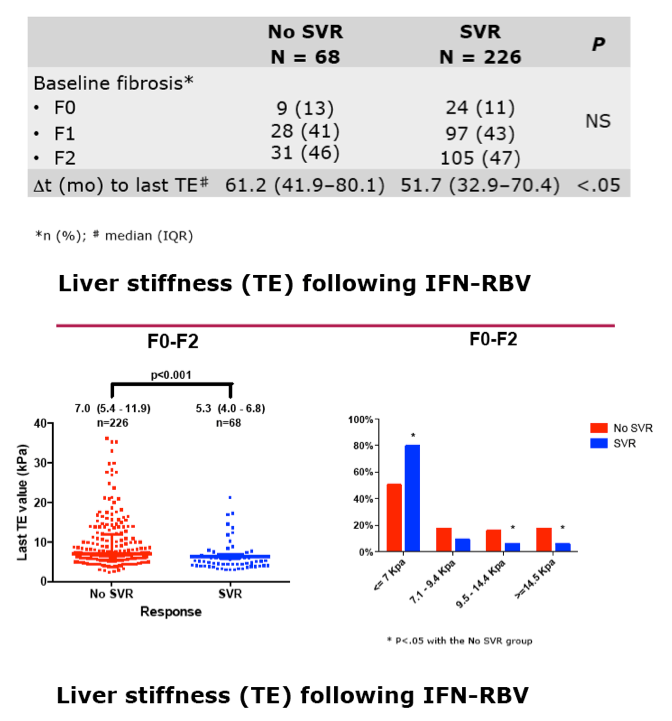
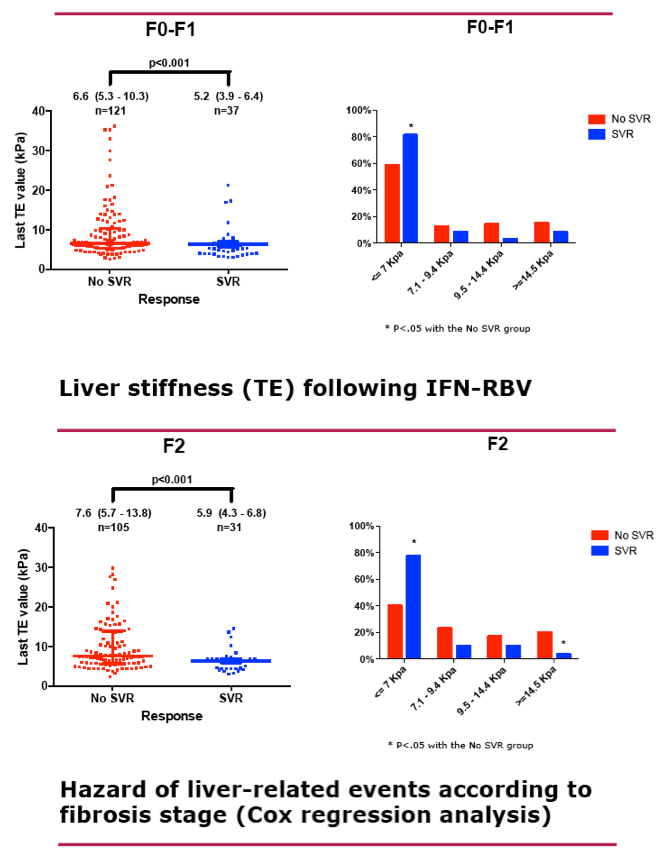
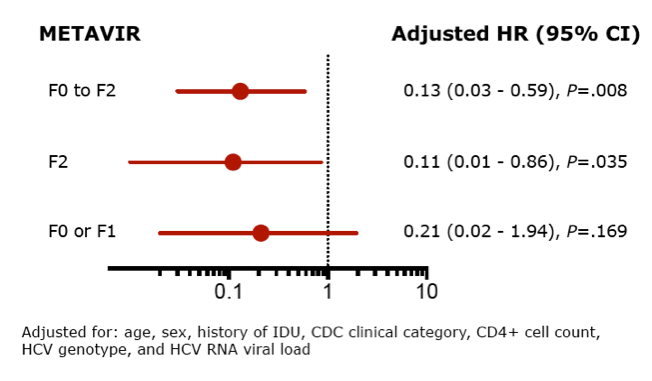
|
| |
|
 |
 |
|
|